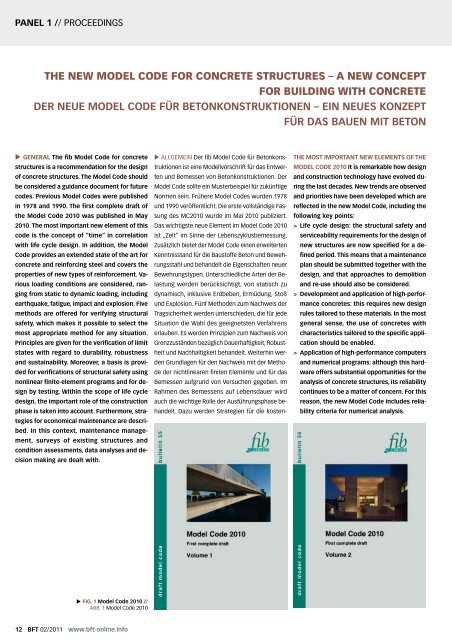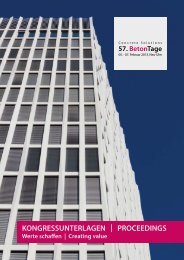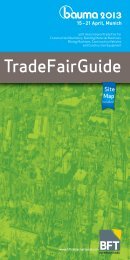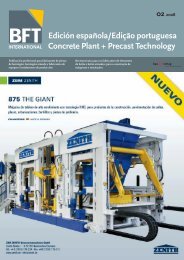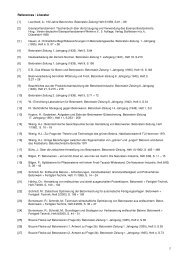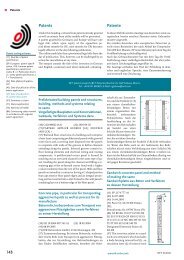Tagungsband - BFT International
Tagungsband - BFT International
Tagungsband - BFT International
Sie wollen auch ein ePaper? Erhöhen Sie die Reichweite Ihrer Titel.
YUMPU macht aus Druck-PDFs automatisch weboptimierte ePaper, die Google liebt.
PANEL 1 // PROCEEDINGS<br />
THE NEW MODEL CODE FOR CONCRETE STRUCTURES – A NEW CONCEPT<br />
FOR BUILDING WITH CONCRETE<br />
DER NEUE MODEL CODE FÜR BETONKONSTRUKTIONEN – EIN NEUES KONZEPT<br />
FÜR DAS BAUEN MIT BETON<br />
� GENERAL The fib Model Code for concrete<br />
structures is a recommendation for the design<br />
of concrete structures. The Model Code should<br />
be considered a guidance document for future<br />
codes. Previous Model Codes were published<br />
in 1978 and 1990. The first complete draft of<br />
the Model Code 2010 was published in May<br />
2010. The most important new element of this<br />
code is the concept of “time” in correlation<br />
with life cycle design. In addition, the Model<br />
Code provides an extended state of the art for<br />
concrete and reinforcing steel and covers the<br />
properties of new types of reinforcement. Va-<br />
rious loading conditions are considered, ran-<br />
ging from static to dynamic loading, including<br />
earthquake, fatigue, impact and explosion. Five<br />
methods are offered for verifying structural<br />
safety, which makes it possible to select the<br />
most appropriate method for any situation.<br />
Principles are given for the verification of limit<br />
states with regard to durability, robustness<br />
and sustainability. Moreover, a basis is provi-<br />
ded for verifications of structural safety using<br />
nonlinear finite-element programs and for de-<br />
sign by testing. Within the scope of life cycle<br />
design, the important role of the construction<br />
phase is taken into account. Furthermore, stra-<br />
tegies for economical maintenance are descri-<br />
bed. In this context, maintenance manage-<br />
ment, surveys of existing structures and<br />
condition assessments, data analyses and de-<br />
cision making are dealt with.<br />
� FIG. 1 Model Code 2010 //<br />
ABB. 1 Model Code 2010<br />
12 <strong>BFT</strong> 02/2011 www.bft-online.info<br />
� ALLGEMEIN Der fib Model Code für Betonkons-<br />
truktionen ist eine Modellvorschrift für das Entwer-<br />
fen und Bemessen von Betonkonstruktionen. Der<br />
Model Code sollte ein Musterbeispiel für zukünftige<br />
Normen sein. Frühere Model Codes wurden 1978<br />
und 1990 veröffentlicht. Die erste vollständige Fas-<br />
sung des MC2010 wurde im Mai 2010 publiziert.<br />
Das wichtigste neue Element im Model Code 2010<br />
ist „Zeit“ im Sinne der Lebenszyklusbemessung.<br />
Zusätzlich bietet der Model Code einen erweiterten<br />
Kenntnisstand für die Baustoffe Beton und Beweh-<br />
rungsstahl und behandelt die Eigenschaften neuer<br />
Bewehrungstypen. Unterschiedliche Arten der Be-<br />
lastung werden berücksichtigt, von statisch zu<br />
dynamisch, inklusive Erdbeben, Ermüdung, Stoß<br />
und Explosion. Fünf Methoden zum Nachweis der<br />
Tragsicherheit werden unterschieden, die für jede<br />
Situation die Wahl des geeignetsten Verfahrens<br />
erlauben. Es werden Prinzipien zum Nachweis von<br />
Grenzzuständen bezüglich Dauerhaftigkeit, Robust-<br />
heit und Nachhaltigkeit behandelt. Weiterhin wer-<br />
den Grundlagen für den Nachweis mit der Metho-<br />
de der nichtlinearen finiten Elemente und für das<br />
Bemessen aufgrund von Versuchen gegeben. Im<br />
Rahmen des Bemessens auf Lebensdauer wird<br />
auch die wichtige Rolle der Ausführungsphase be-<br />
handelt. Dazu werden Strategien für die kosten-<br />
THE MOST IMPORTANT NEW ELEMENTS OF THE<br />
MODEL CODE 2010 It is remarkable how design<br />
and construction technology have evolved du-<br />
ring the last decades. New trends are observed<br />
and priorities have been developed which are<br />
reflected in the new Model Code, including the<br />
following key points:<br />
> Life cycle design: the structural safety and<br />
serviceability requirements for the design of<br />
new structures are now specified for a de-<br />
fined period. This means that a maintenance<br />
plan should be submitted together with the<br />
design, and that approaches to demolition<br />
and re-use should also be considered.<br />
> Development and application of high-perfor-<br />
mance concretes: this requires new design<br />
rules tailored to these materials. In the most<br />
general sense, the use of concretes with<br />
characteristics tailored to the specific appli-<br />
cation should be enabled.<br />
> Application of high-performance computers<br />
and numerical programs: although this hard-<br />
ware offers substantial opportunities for the<br />
analysis of concrete structures, its reliability<br />
continues to be a matter of concern. For this<br />
reason, the new Model Code includes relia-<br />
bility criteria for numerical analysis.


